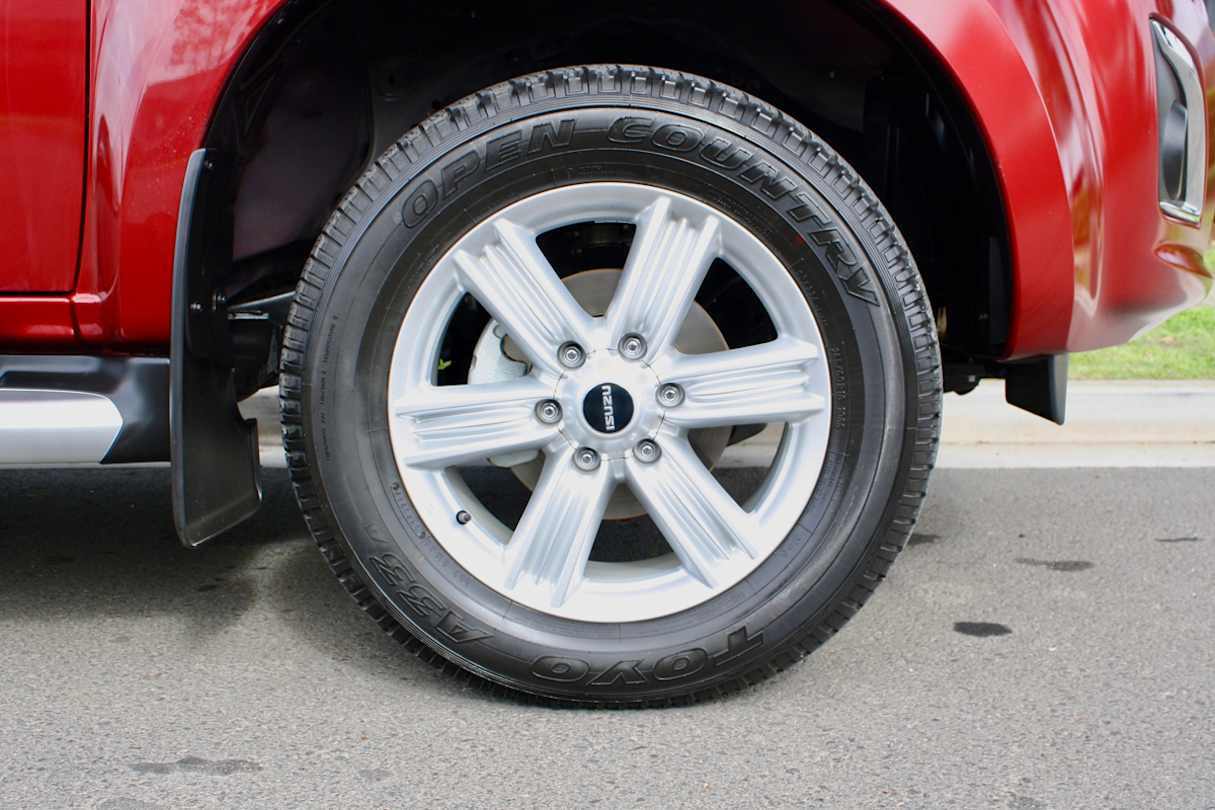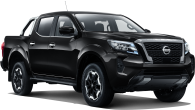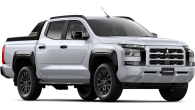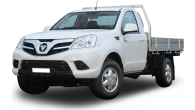The Isuzu D-Max soldiers on in the ute segment, with customers drawn to its purportedly reliable truck engine and no-frills approach the dual cab pick-up market.
It mightn’t be the first, second or third double-cab on your list - and, in fact, it currently ranks fifth in the class in terms of sales.
So why should you consider one? Or should you consider one at all?
And if you should, does the top-spec LS-T model make sense?
Isuzu D-MAX 2019: LS-Terrain Hi-Ride (4x4)
| Engine Type | Diesel Turbo 4, 3.0L |
|---|---|
| Fuel Type | Diesel |
| Fuel Efficiency | 7.9L/100km (combined) |
| Seating | 5 |
| Price From | $34,100 - $40,590 |
| Safety Rating |
|
Is there anything interesting about its design?
7 / 10
The exterior design of the D-Max is largely unchanged since the introduction of the current-generation version in 2012. But it was handsome then, and its appearance has stood the test of time pretty well.
There have been minute appearance adjustments but it’s nigh-on impossible to pick the differences between a D-Max from 2012 and the one on sale in 2019. You could see that as both positive because earlier models aren’t easily discernible, or negative because some of its contemporaries look, well, more contemporary.

There’s no real ‘hero’ model in the D-Max range - nothing like the VW Amarok V6 Ultimate, or the Toyota HiLux Rugged X, or the Ford Ranger Wildtrak or Raptor. So it’s fair to say that this model is a bit plain, even if the 18-inch alloy wheels and fancy 'Magnetic Red mica' paint are quite fresh.
It mightn’t have muscular underbody protection armour, and no model comes as standard with a body kit (eBay Thailand will help you in that regard). You need to spend extra to get the nice looking hardtop / hard tonneau cover (at $2655) if you prefer that to the soft tonneau of our vehicle, and the alloy sports bar at the rear is an added-cost bit, too (at $845), where plenty of competitors have one of those on their top-spec models at no cost.
Items like the rear step bumper and side steps are fitted standard, though, and you get roof rails, which makes adding roof racks or roof bars even easier.

In terms of dimensions, the size of the D-Max dual-cab is about what you’d expect of most utes like it: the pick-up version measures 5295mm long (on a 3095mm wheelbase), 1860mm wide and 1855mm tall.
Check out our interior photos for an idea of the design of the D-Max’s cabin, but we’ll got through it in detail in the following section.
How practical is the space inside?
7 / 10
The good news for customers is that there’s a choice of different body styles. Whether you want a cab chassis or pick-up, a dual cab, extra cab / space cab, or a single-cab, there’s a D-Max for you. If you choose a cab-chassis model, you’ll need to add an aluminium or steel tray at extra cost, but that way, you can tailor the tray to your needs.
The vast majority of buyers, though, are choosing a dual cab pick-up model - it has a bit more dual-purpose appeal, and with a canopy on the back, it’s like you’ve got an SUV with the boot size to make most green with envy. The dual cab pick-up model’s tray dimensions are 1552mm long, 1530mm wide (and 1105mm between the wheel-arches, meaning it can’t cope with a pallet), and 465mm deep.
Now, the cabin… and it looks and feels like a work-focused ute, one that clearly has been around a little while. Don’t expect anything like the cabin you’ll find in the Ranger or Amarok, or even the X-Class or Navara.
But there are some niceties in this top-spec model, including an 8.0-inch media screen with Bluetooth phone and audio (which is painful to connect to and continually disconnected between drive), and you get a couple of USB ports (x2 up front, x1 in the back) and you get sat nav included, too. But it lacks the latest smartphone integration of Apple CarPlay and Android Auto, which many of its rivals have, and the screen can arrange itself in such a way that when it’s playing back connected media, it won’t show the clock anymore. That’s annoying.
This grade features a leather-trimmed steering wheel with cruise control and audio buttons on board, too. But like a few of its rivals, it lacks steering wheel reach adjustment, so long-legged-short-armed drivers might struggle to get their perfect spot.
Storage is decent, with cup holders between the seats, twin cup holders on either edge of the dashboard, decent door pockets with bottle holders all around, a twin glove box section and a dash-top bin (with the flimsiest lid imaginable). Shame there’s nowhere good to slot a large smartphone, though, as the spot near the USBs is pretty useless.
In the back there’s enough space for three adults across, and someone my size (I’m 182cm tall) can fit behind a similarly-sized driver without much hassle. The knee room is better than some other utes, and the cabin width and headroom are good, too. The backrest of the seat is pretty upright and not the most comfortable for long trips, though.
There is a pair of cup holders that flip down onto the floor, there’s a fold-down centre armrest as well, and there are twin map pockets - but no rear air vents.
If you plan to carry luggage or tools with you, and you don’t have a lockable tonneau or canopy, then you can fold up the seat bases of the rear bench to open up a large, relatively flat area to keep things dry and (hopefully) secure.
Does it represent good value for the price? What features does it come with?
7 / 10
How much does a D-Max cost? It’s a common question, and of course price will determine which models in the range appeal most to you.
While this is not a full-scale model comparison, See our spec guide and price list to help you figure it out.
Our vehicle is the LS-T auto flagship model, listing at $54,700 plus on-road costs. But there are often appealing drive-away deals at Isuzu dealers, so it pays to shop around - at the time of writing, this model is on sale at $51,490 drive away.
As such, the LS-T squares off against the following utes (all prices before on-road costs): Toyota HiLux SR5 auto ($56,440); VW Amarok V6 Sportline auto ($55,990); Nissan Navara ST-X auto ($52,490); Mitsubishi Triton Exceed auto ($48,990); Holden Colorado Z71 auto ($57,190); Ford Ranger XLT auto ($58,190).
Standard equipment for this version includes an 8.0-inch touchscreen media system with Bluetooth phone and audio streaming, plus there’s a sat nav / GPS navigation system included in mid- to high-grade models. The sound system has six speakers (no subwoofer), plus it has a CD player and radio if you don’t want to connect an MP3 player. There’s no DVD player like you get in the top-spec MU-X, though, and the sound system isn’t nearly as good as the equivalent Isuzu SUV, either.

The LS-T includes 2xUSB ports up front (plus a rear-seat USB charger), a reversing camera, plus 18-inch alloys and leather seats with electric driver’s seat adjustment. Unlike some rivals, there’s no digital speedometer.
This spec gets LED daytime running lights with projector headlights (sadly, Isuzu hasn’t adopted the brilliant LED headlights it fits to the MU-X), and there’s no privacy glass - but you do get side steps. You also get single-zone climate control, keyless entry and push-button start.
What’s missing? You can’t get a sunroof in any grade, even optionally, and there’s no diff lock or limited slip diff available.

The accessories list isn’t limited to features such as floor mats and rims - the genuine Isuzu additions list features goodies like a bullbar, nudge bar, snorkel, ladder rack and sports bar. Our vehicle had a rubber mat in the tray ($165) but if you prefer a tray liner that’ll set you back at least $550.
While most utes sold are white (and that won’t cost you any extra), colours available for the D-Max include 'Cobalt Blue mica', 'Cosmic Black mica', 'Magnetic Red mica', 'Obsidian Grey mica' and 'Titanium Silver metallic', all of which will add $550 to the price. There are no orange, green or gold options.
What are the key stats for the engine and transmission?
7 / 10
Let’s talk engine specs.
The D-Max’s engine size is a 3.0-litre diesel motor with a single turbocharger, producing 130kW (or about 175 horse power) and 430Nm of torque. It has a diesel particulate filter, so it meets Euro 5 emissions regulations, and if you’re curious about whether it has a timing belt or chain, it’s the latter.

The outputs don’t change whether you choose the six-speed manual transmission or the six-speed automatic transmission, and the same can be said whether you choose the 4x2 / 2WD (rear wheel drive) or 4x4 / 4WD (four-wheel drive) model.
Considering fitting a tow bar? The towing capacity for dual cab 4x4 models is 750 kilograms (unbraked trailer), or 3500kg for a braked trailer.
What about load capacity? Our review this time around wasn’t focused on carrying a lot of weight, but even in this top-spec LS-T grade the payload is still above a tonne, at 1024kg. We came to that figure by deducting the LS-T’s kerb weight (2026kg) from the gross vehicle weight (also known as gross vehicle mass or GVM), which is 3050kg.
Fuel tank capacity is 76 litres in size. Sadly, you can’t get a D-Max with a diesel long-range fuel tank. And if you prefer petrol, you’re out of luck.
If you’re concerned about potential engine problems, suspension, clutch, gearbox, diesel injector and automatic transmission problems, you might want to check out our dedicated Isuzu D-Max problems page.
How much fuel does it consume?
7 / 10
Diesel fuel economy is rated at between 7.2 litres and 8.1 litres per 100 kilometres depending on the model you choose (our LS-U 4x4 auto claims 7.9L/100km). In the real world, you can expect to see fuel consumption of about 9.5L/100km in normal driving, or a bit more if you’re heading off-road or dealing with heavy loads.
Mileage - based on the claimed consumption - should be as good as 962km for a full 76L tank, but we’d expect you’d be more likely to get about 780km.
There’s no reason to consider petrol consumption - there is no petrol version of the D-Max.
What's it like to drive?
7 / 10
There are about a dozen utes in the segment, and in this writer’s opinion, the Isuzu D-Max doesn’t rank in the top half in terms of the drive experience. But that arguably says more about the rivals than it does about the D-Max, because it isn’t deplorable by any stretch of the imagination.
The thing that lets the LS-T version down most is its ride comfort. The rear end is sharp with nothing in the tray, and that’s how a lot of utes get around these days - and vehicles like the Ranger, Colorado and Amarok all feel more settled in that situation. I guess you could fit air suspension to the rear to fix it, if it really mattered to you?

The front suspension isn’t terrific, either, feeling loose and jagged over sharp edges, with the steering kicking in the driver’s hands over bumps in corners. The steering is heavy and nowhere near as good as rivals, with a big turning circle and hefty weighting making it a touch cumbersome when you’re parking. The turning radius (or turning circle) is 12.6m, and it needs 3.8 turns lock-to-lock. That’s quite a bit of arm-twirling.
If you live and die by performance, breathe 0-100 acceleration times, and your pulse races when you think about speed.. you’re in the wrong place looking at an Isuzu ute review.
Sure, the 3.0-litre turbo-diesel engine in the Isuzu - with 130kW/430Nm - isn’t slow, but it feels more focused on hard work and dealing with heavy loads than offering a rewarding experience for the driver. It’s pretty vocal under mid-to-hard throttle, too.
The transmission is good at lower speeds, dealing with day-to-day traffic and city stop-start stuff without any real grievances. But if you do a lot of highway commuting you could find yourself becoming frustrated by the transmission’s indecisive nature at pace. Between 80km/h and 110km/h it’s like a kid trying to choose a lolly when you go to do the shopping, struggling to make its mind up on which gear to go with.

Let’s discuss off road capability. In terms of specs, the Isuzu D-Max LS-T has a ground clearance of 235mm, the highest in the range alongside the LS-U model, but the brand does’t specify the wading depth of the ute. The approach angle is 30.0 degrees, the ramp-over angle is 22.3deg, and the departure angle is 22.7deg - all of which are pretty competitive for the class, and enough to ensure you’ll be able to ascend, descend and switch over without much hassle.
You might want to consider smaller alloy wheels if you’re considering a set of off road tyres, but the 255/60 x 18 highway rubber on the LS-T model still allows you to deal with dirt roads, shallow mud puddles and some rocky sections. For more serious terrain, you’d probably want to consider a different tyre.
Warranty & Safety Rating
What safety equipment is fitted? What safety rating?
6 / 10
The D-Max scored a five-star ANCAP safety rating way back in 2013, which was upgraded in November 2016… but by ANCAP’s ever-tightening regime, it wouldn’t score that today.
Isuzu doesn’t offer the same level of advanced safety technology as its rivals. There is no auto emergency braking (AEB) or lane keeping tech, and no blind spot monitoring or rear cross-traffic alert, either.
On this top-spec model you get a reverse camera but no rear parking sensors (you can option them, at $418). There are six airbags, including dual front, front side and full-length curtain airbags.
Unlike the MU-X SUV, there are no ISOFIX child seat anchor points in the D-Max. You do get three top-tether attachments for child restraints, however.
What does it cost to own? What warranty is offered?
8 / 10
Isuzu offers a five-year/130,000km warranty and the same cover for capped price servicing.
The service intervals are set at 12 months/15,000km, and the average service cost over the five-year period working out at $418 per visit, if you stick to the set schedule in the owners manual.
Verdict
If I hadn’t driven any of the other 4x4 utes in the segment, I’d probably come away from a test drive in the Isuzu D-Max LS-T pretty impressed. But I have. And for me, when considered against its rivals, the Isuzu D-Max LS-T falls a little short of expectations.
While you have to pay more to get into an Amarok or a Ranger, you’ll get better refinement and tech in each instance. Directly cross-shopping this vehicle against value offerings like the BT-50, Triton, Navara and Colorado? Well, each has different elements that make them as appealing as the Isuzu, if not more so - particularly in high-spec guise.
Our advice? If you can get a good deal, the flagship D-Max could be a compelling purchase - just make sure you shop around.
Which top-spec dual cab ute would you buy? Let us know in the comments section below.
Pricing Guides
.png)

.jpg)
















.jpg)
.jpg)
.jpg)









.jpg)
.jpg)



